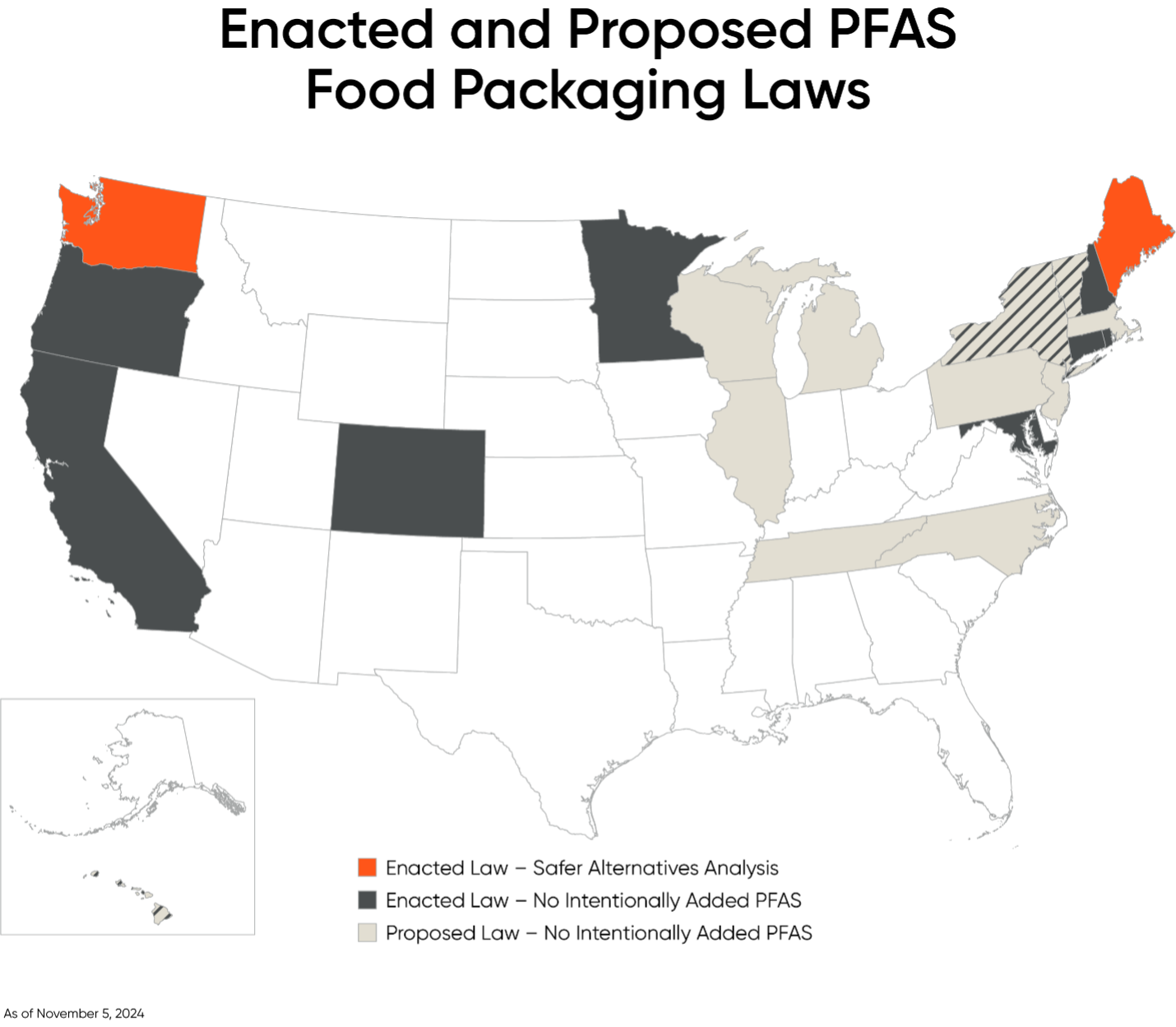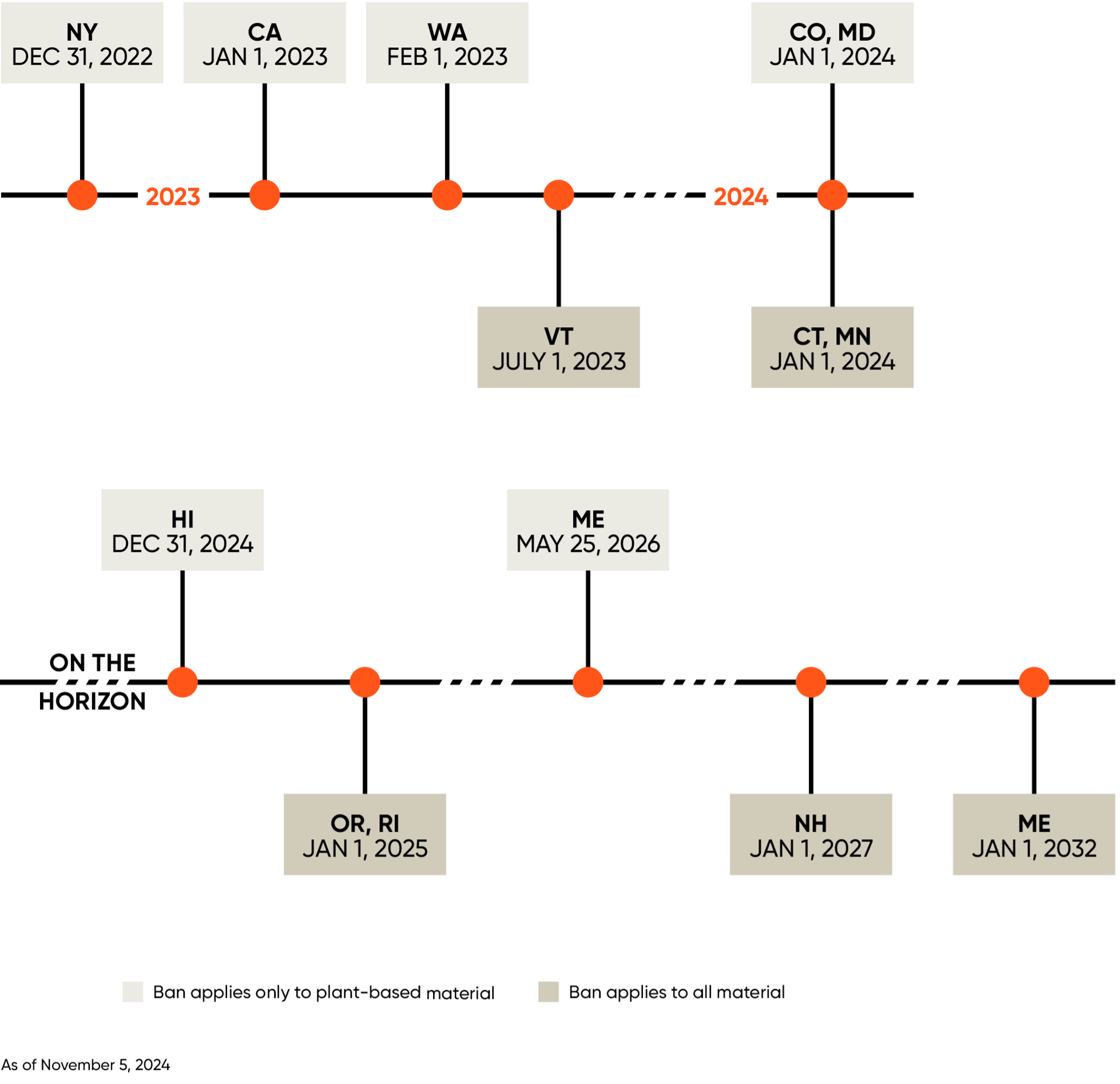BCLPemerging.com
PFAS in food packaging: state-by-state regulations
Updated: November 2024
Nov 13, 2024Summary
In the absence of comprehensive federal regulation of PFAS in food packaging, states are dishing out their own laws. Thus far, 13 (thirteen) states have enacted laws addressing PFAS substances in food containers and packaging materials (“Food Packaging”), and there are 15 (fifteen) proposed bills that are currently pending in various states. These laws are intended to address concerns that storing food in Food Packaging that contains PFAS compounds may result in increased ingestion of those PFAS substances. Related to food packaging, a growing number of states are enacting or proposing general bills involving the recyclability of food or beverage packaging, but this client alert does not specifically address those requirements as these measures do not exclusively involve PFAS substances.
According to the United States Environmental Protection Agency (“EPA”), commonly cited examples of Food Packaging that have historically contained PFAS substances include “grease-resistant paper, fast food containers/wrappers, microwave popcorn bags, pizza boxes, and candy wrappers.”
Federal Actions
On February 28, 2024, the Food and Drug Administration (“FDA”), announced that grease-proofing substances containing PFAS materials are “no longer being sold by manufacturers for food contact use in the U.S. market.”
The shift is not the result of a formal ban or restriction on food contact surfaces; instead, FDA reports that it has secured voluntary agreements from food packaging manufacturers that they will not to use PFAS substances especially after 2020. In furtherance of these efforts, FDA states the following: this “announcement marks the fulfillment of a voluntary commitment by manufacturers to not sell food contact substances containing certain PFAS intended for use as grease-proofing agents in the U.S. This FDA-led effort represents a positive step forward as we continue to reevaluate chemicals authorized for use with, and in, food.”
Despite the fanfare, FDA’s “mission accomplished” is limited in numerous ways. First, it is the result of a voluntary commitment from current food packaging manufacturers, but there may be issues with ensuring compliance from new and international manufacturers. Second, this applies solely to grease-proofing substances and does not address the many other types of PFAS uses in food packaging. Third, from a compliance standpoint, the enacted state laws go well beyond regulating just grease-proofing substances, so businesses will still need to evaluate what state laws apply to their food packaging products and whether changes are necessary to achieve compliance.
In addition, on September 27, 2024, Representative Debbie Dingle (D. MI) introduced a bill in the House of Representatives which would prohibit the distribution of food packaging containing intentionally added PFAS in interstate commerce. It has been referred to committee and it is unclear whether it will pass and be signed into law, but it suggests the possibility of federal action on this issue.
State Food Packaging Laws
In response to this perceived health risk, state legislatures have enacted and proposed a variety of different laws to curtail the use of PFAS in food packaging. In terms of the types of regulatory approaches, states have generally adopted either a safer alternatives framework, or a prohibition on intentionally added PFAS. Under the safer alternatives framework, an organization or state agency conducts a safer alternatives analysis to determine if a viable option is commercially available both in sufficient quantity and at a comparable cost for various food packaging items containing intentionally added PFAS. Usually, the safer alternative must perform as well as or better than the specific food package containing PFAS.
With respect to the scope of “food packaging” that is subject to the state laws, some states have limited the definition to plant or fiber-based food packaging, while other states have included all food packaging. The one constant in the variety of regulatory approaches seems to be the broad definition of PFAS which is universally: “fluorinated organic chemicals containing at least one fully fluorinated carbon atom.”
This map and the following information below provide a more detailed analysis of each state’s regulatory approach, and is current as of November 5, 2024. This area of law is constantly changing as demonstrated by the number of bills that are currently being proposed.

Enacted Law - no intentionally added PFAS |
|
Effective date
January 1, 2023
Food Packaging Description
No person shall distribute or sell any food packaging that either has:
- PFAS that are intentionally added to a product and that has a functional or technical effect in the product; or
- More than 100 ppm of PFAS substances as measured in total organic fluorine.
“Food packaging” is defined as “a nondurable package, packaging component, or food service ware that is intended to contain, serve, store, handle, protect, or market food, foodstuffs, or beverages, and is comprised, in substantial part, of paper, paperboard, or other materials originally derived from plant fibers.”
Packaging Distinction
Plant-based food packaging
Regulatory Status
Enacted
Details
Enforcement Letter for AB 1200
Effective date
January 1, 2024
Food Packaging Description
No person shall sell or distribute any product in the food packaging category if the product contains intentionally added PFAS substances.
"Food packaging" is defined as “a package or packaging component used in direct contact with food and that is composed, in substantial part, of paper, paperboard, or other materials originally derived from plant fibers.”
Packaging Distinction
Plant-based food packaging
Regulatory Status
Enacted
Details
Effective date
January 1, 2024
Food Packaging Description
No food package to which PFAS substances are intentionally introduced in any amount during manufacturing or distribution shall be offered for sale or for promotional purposes by its manufacturer or distributor.
"Food packaging" is defined as “any package or packaging component that is applied to or in direct contact with any food or beverage.”
Packaging Distinction
All food packaging
Regulatory Status
Enacted
Details
Effective date
December 31, 2024
Food Packaging Description
It is unlawful to manufacture, sell, or distribute certain food packaging (specifically wraps and liners, plates, food boats, and pizza boxes) to which PFAS chemicals have been intentionally introduced in any amount.
"Food packaging" is defined as “a package or packaging component that is applied to or in direct contact with any food or beverage and is comprised, in substantial part, of paper, paperboard, or other materials originally derived from plant fibers.”
Packaging Distinction
Plant-based food packaging
Regulatory Status
Enacted
Details
Effective date
January 1, 2024
Food Packaging Description
A manufacturer or distributor may not manufacture, distribute, or sell a food package to which PFAS substances have been intentionally added.
“Food package” means a package that is designed and intended for direct food contact and is composed, in substantial part, of paper, paperboard, or other materials originally derived from plant fibers, including: (1) a food or beverage product that is contained in a food package or to which a food package is applied; (2) a packaging component of a food package; and (3) plastic disposable gloves used in commercial or institutional food service.”
Packaging Distinction
Plant-based food packaging
Regulatory Status
Enacted
Details
Effective date
January 1, 2024
Food Packaging Description
No person shall manufacture, sell, distribute, or offer for use a food package that contains intentionally added PFAS.
"Food package" is defined as “a container applied to or providing a means to market, protect, handle, deliver, serve, contain, or store a food or beverage.”
Food package includes: “(1) a unit package, an intermediate package, and a shipping container; (2) unsealed receptacles, such as carrying cases, crates, cups, plates, bowls, pails, rigid foil and other trays, wrappers and wrapping films, bags, and tubs; and (3) an individual assembled part of a food package, such as any interior or exterior blocking, bracing, cushioning, weatherproofing, exterior strapping, coatings, closures, inks, and labels.”
Packaging Distinction
All food packaging
Regulatory Status
Enacted
Details
Effective date
January 1, 2027
Food Packaging Description
Food packaging and containers shall be prohibited from being sold, offered for sale, or distributed for sale or for promotional purposes.
“Food containers” are defined as containers applied to or providing a means to market, protect, handle, deliver, serve, contain, or store a food or beverage.
“Food packaging” includes: (1) a unit package, an intermediate package, and a shipping container; (2) unsealed receptacles, such as carrying cases, crates, cups, plates, bowls, pails, rigid foil and other trays, wrappers and wrapping films, bags, and tubs; and (3) an individual assembled part of a food package, such as any interior or exterior blocking, bracing, cushioning, weatherproofing, exterior strapping, coatings, closures, inks, and labels.
Packaging Distinction
All food packaging
Regulatory Status
Enacted
Details
Effective date
December 31, 2022
Food Packaging Description
No person shall distribute or sell food packaging containing PFAS substances as intentionally added chemicals.
"Food packaging" is defined as “a package or packaging component that is intended for direct food contact and is comprised, in substantial part, of paper, paperboard, or other materials originally derived from plant fibers.”
Packaging Distinction
Plant-based food packaging
Regulatory Status
Enacted
Details
New York Department of Environmental Conservation Information
Effective date
January 1, 2025
Food Packaging Description
A person may not sell or distribute a foodware container containing intentionally added PFAS substances.
“Foodware container” includes the following: bowls, plates, cups, lids, clamshells or other containers or any other items used for serving or containing prepared food, including takeout food and leftovers from partially consumed meals prepared by food vendors.
“Food vendor” is defined as “a business, organization or other person that sells prepared food or offers prepared food for sale to the public, including, but not limited to, a store, shop or other sales outlet, a restaurant, a delicatessen or a cart, truck or other vehicle from which the business, organization or other person sells prepared food or offers prepared food for sale.”
Packaging Distinction
All food packaging
Regulatory Status
Enacted
Details
Oregon Department of Environmental Quality Information
Effective date
January 1, 2025
Food Packaging Description
No manufacturer or distributor shall sell a food package in which PFAS substances have been intentionally introduced in any amount.
"Food packaging" is defined as “any package or packaging component that is applied to or in direct contact with any food or beverage.”
Packaging Distinction
All food packaging
Regulatory Status
Enacted
Details
Effective date
July 1, 2023
Food Packaging Description
A manufacturer, supplier, or distributor shall not manufacture, sell, or distribute a food package to which PFAS substances have been intentionally added and are present in any amount.
“Food package” or “food packaging” means a package or packaging component that is intended for direct food contact.
“Package” is defined as “a container providing a means of marketing, protecting, or handling a product and shall include a unit package, an intermediate package, and a shipping container. Package also means unsealed receptacles, such as carrying cases, crates, cups, pails, rigid foil and other trays, wrappers and wrapping films, bags, and tubs.”
“Packaging component” is defined as “an individual assembled part of a package, such as any interior or exterior blocking, bracing, cushioning, weatherproofing, exterior strapping, coatings, closures, inks, and labels, and disposable gloves used in commercial or institutional food service.”
Packaging Distinction
All food packaging
Regulatory Status
Enacted
Details
Vermont Department of Health Information
Vermont Department of Health Guidance for Manufacturers, Suppliers, and Distributors
proposed Law - no intentionally added PFAS |
|
Effective date
December 31, 2026
Food Packaging Description
It shall be unlawful to manufacture, sell, or distribute any food packaging that contains intentionally added PFAS, subject to some exceptions.
The proposed law has no definition of food packaging, but it includes all kinds of food packaging (including food service ware) whereas the enacted law includes only certain types of food packaging.
Packaging Distinction
All food packaging
Regulatory Status
Proposed
Details
Effective date
January 1, 2025
Food Packaging Description
No person shall sell or distribute food packaging if it contains an intentionally added PFAS.
“Food Packaging” is defined as “a package or packaging component that is applied to or in direct contact with any food or beverage and is comprised, in substantial part, of paper, paperboard, or other materials originally derived from plant fibers.”
Packaging Distinction
Plant-based food packaging
Regulatory Status
Proposed
Details
Effective date
January 1, 2028
Food Packaging Description
No person or entity shall manufacture, sell, or distribute food packaging to which PFAS substances have been intentionally added in any amount.
“Food package" is defined as “a package or packaging component that is intended for the marketing, protection or handling of a product intended for food contact or used to store food and foodstuffs for sale.”
Packaging Distinction
All food packaging
Regulatory Status
Proposed Bill I
Details
Effective date
Two years after the effective date of the legislation
Food Packaging Description
No person or entity may sell or distribute any beverage container, food ware accessories, food ware, or food packaging containing PFAS substances.
“Food packaging” is defined as “any packaging that comes into direct contact with food that will eventually be consumed by human beings or animals.”
Packaging Distinction
All food packaging
Regulatory Status
Proposed Bill II
Details
Effective date
January 1, 2025
Food Packaging Description
A person shall not manufacture, sell, or distribute food packaging that has PFAS intentionally added in any amount greater than an incidental presence.
"Food packaging" means a container or wrapper that provides a means of marketing, protecting, or handling a food and that is intended for direct food contact. Food packaging includes an unsealed receptacle, such as a carrying case, crate, cup, pail, rigid foil or other tray, wrapping film, bag, or tub. Food packaging includes the food that is contained in the food packaging, the food to which the food packaging is applied, and a plastic, disposable glove used in commercial or institutional food service.
"Incidental presence" is defined as “the presence of a chemical as an unintended or undesired ingredient.
Packaging Distinction
All food packaging
Regulatory Status
Proposed
Details
Effective date
Two years after the effective date of the legislation
Food Packaging Description
No person shall sell or distribute any food packaging that contains an intentionally added PFAS substance unless it “contains a technically unavoidable trace quantity of PFAS, which stems from impurities of natural or synthetic ingredients or the manufacturing process, storage, or migration from packaging of the product.”
“Food Packaging” is defined as “a nondurable package, packaging component, or food service ware that is intended to contain, serve, store, handle, protect, or market food, foodstuffs, or beverages, and is composed, in substantial part, of paper, paperboard, or other materials originally derived from plant fibers.”
Food packaging includes the following: food or beverage containers, take-out food containers, unit product boxes, liners, wrappers, serving vessels, eating utensils, straws, food boxes, and disposable plates, bowls, or trays.
Packaging Distinction
Plant-based food packaging
Regulatory Status
Proposed
Details
Effective date
Three years after the effective date of the legislation
Food Packaging Description
No person or entity shall sell or distribute any packaging material containing PFAS substances.
"Packaging material" means a discrete material or category of material, regardless of recyclability, including but not limited to such material types that are flexible, foam, or rigid material, including paper, cardboard, plastic, glass, metal, or multi-material, that is used for the containment, protection, handling, delivery, transport, distribution, or presentation of another product that is sold, offered for sale, imported, or distributed in the state, including through an internet transaction, and single-use plastic products that frequent the residential waste stream or are plastic products that have the effect of disrupting recycling processes, including, but not limited to, single-use plastic items such as straws, utensils, cups, plates, and plastic bags subject to some exceptions.
Packaging Distinction
All food packaging
Regulatory Status
Proposed
Details
Effective date
October 1, 2025
Food Packaging Description
No person may manufacture, sell, or offer for sale any covered product, including food packaging, that contains intentionally added PFAS.
Food Packaging: A package, compostable container, or packaging component that is intended for direct food content.
Intentionally added PFAS: (1) PFAS added to a product or one of the product's components that have a function or technical effect in the product; or (2) PFAS used or produced during the manufacture or processing of a product, including any source of PFAS that is reasonably known to be present, such as using processing agents, mold release agents, or fluorination.
Packaging Distinction
All food packaging
Regulatory Status
Proposed Bill I
Details
Effective date
October 1, 2025
Food Packaging Description
No person may manufacture, distribute, sell, export, or use any packaging material containing a PFAS substance.
“Packaging material” is defined as “any part of a package or container, regardless of recyclability or compostability, including material types such as paper, plastic, glass, or metal, that is used for the containment, protection, handling, delivery, transport, distribution, and presentation of a product that is sold, offered for sale, or distributed in North Carolina. Bags are included within this definition.”
Packaging Distinction
All food packaging (and also a general requirement for other packaging)
Regulatory Status
Proposed Bill II
Details
Effective date
January 1, 2027
Food Packaging Description
A person may not manufacture, sell, or offer for sale a covered product, including food packaging, that contains an intentionally added PFAS chemical.
"Food packaging” is defined as a “package or packaging component that is intended for direct food contact.”
Packaging Distinction
All food packaging
Regulatory Status
Proposed Bill I
Details
Effective date
Immediately after Enactment
Food Packaging Description
No person shall distribute, sell, or offer for sale food packaging containing PFAS substances in any amount.
"Food packaging” is defined as “a container or component that is intended for direct food contact.”
Packaging Distinction
All food packaging
Regulatory Status
Proposed Bill II
Details
Effective date
July 1, 2028
Food Packaging Description
A person shall not sell or distribute any packaging designed to include PFAS substances.
"Packaging materials" is defined as “means, regardless of recyclability, a part of a package or container, including material that is used for the containment, protection, handling, delivery, and presentation of a product that is sold, offered for sale, imported, or distributed in this state; and includes: (i) primary, secondary, and tertiary packaging intended for the consumer market; and (ii) service packaging designed and intended to be filled at the point of sale, including carry-out bags, bulk goods bags, and take-out and home delivery food service packaging.”
Packaging Distinction
All food packaging
Regulatory Status
Proposed Bill I
Details
Effective date
January 1, 2025
Food Packaging Description
A person shall not manufacture, offer for sale, or distribute a product that contains intentionally added PFAS substances in numerous products, including food packaging.
Food package: “(A) Means a container applied to or providing a means to market, protect, handle, deliver, serve, contain, or store a food or beverage; and (B) Includes:
(i) A unit package, an intermediate package, or shipping container;
(ii) Unsealed receptacles, such as carrying cases, crates, cups, plates, bowls, pails, rigid foil and other trays, wrappers and wrapping films, bags, and tubs; and
(iii) An individual assembled part of a food package, such as any interior or exterior blocking, bracing, cushioning, weatherproofing, exterior strapping, coatings, closures, inks, and labels.”
Packaging Distinction
All food packaging
Regulatory Status
Proposed Bill II
Details
Effective date
July 1, 2030
Food Packaging Description
A manufacturer, supplier, or distributor shall not manufacture, sell, or distribute any product that contains intentionally added PFAS, unless the Vermont Department of Health has that the use of PFAS in a product is currently an unavoidable use.
“Product” is defined as “an item manufactured, assembled, packaged, or otherwise prepared for sale to consumer, including its product components, sold or distributed for personal, residential, commercial, or industrial use, including for use in making products.”
Packaging Distinction
All food packaging
Regulatory Status
Proposed
Details
Effective date
January 1, 2028
Food Packaging Description
No person may distribute, sell, or offer for sale food packaging, or food products contained in food packaging, if the product contains intentionally added PFAS.
“Food packaging" is defined as a container applied to or providing a means to market, protect, handle, deliver, serve, contain, or store a food or beverage.
“Food packaging” includes a unit package, an intermediate package, and a shipping
container; unsealed receptacles, such as carrying cases, crates, cups, plates, bowls, pails, rigid foil and other trays, wrappers and wrapping films, bags, and tubs; and an individually assembled part of a food package, such as any interior or exterior blocking, bracing, cushioning, weatherproofing, exterior strapping, coating, closure, ink, and label.
Packaging Distinction
All food packaging
Regulatory Status
Proposed
Details
Enacted Law - Safer Alternatives Analysis |
|
Effective date
January 1, 2026 (notification)
May 25, 2026 (food packaging)
January 1, 2032 (all products that contain intentionally added PFAS)
Food Packaging Description
Beginning on January 1, 2026, a manufacturer of a product that contains intentionally added PFAS shall submit a written notification to the Maine Department of Environmental Protection (“MDEP”).
Beginning on May 25, 2026, a manufacturer, supplier, or distributor may not offer for sale any food packaging intended for direct food contact comprised of materials derived from plant fibers to which PFAS have been intentionally introduced in any amount greater than an incidental presence.
Beginning on January 1, 2032, a person may not sell or distribute any product that contains intentionally added PFAS, unless MDEP has determined that the use of PFAS in the product is of unavoidable use.
Packaging Distinction
Plant-based Food Packaging (2026) and All Food Packaging (2032)
Regulatory Status
Enacted
Details
32 M.S.R.A. 26-A.1733, LD 217 and LD 1537
Effective date
February 1, 2023
Food Packaging Description
No person may manufacture, sell, or distribute food packaging to which PFAS chemicals have been intentionally added in any amount. This prohibition may not take effect until the Department of Ecology (“DOE”) identifies that safer alternatives are available.
"Food package" is defined as “a package or packaging component that is intended for direct food contact and is comprised, in substantial part, of paper, paperboard, or other materials originally derived from plant fibers.”
"Safer alternative" is defined as “an alternative substance or chemical, demonstrated by an alternatives assessment, that meets improved hazard and exposure considerations and can be practicably and economically substituted for the original chemical.”
DOE published a first report, dated February 2021, specifically stating that: (1) six chemical alternatives were less hazardous than PFAS; (2) one chemical alternative was more hazardous than PFAS; and (3) the data was insufficient to evaluate three chemical alternatives.
DOE published a second report, dated May 2022, that identified numerous alternatives for PFAS substances in the following five categories of food packaging: 1) bags and sleeves; 2) bowls; 3) flat serviceware; 4) open-top containers; and 5) closed containers.
According to DOE, food packaging manufacturers, distributors, and retailers may not manufacture, sell, or distribute:
(1) Wraps, plates, food boats, or pizza boxes with PFAS chemicals intentionally added as of February 1, 2023; and
(2) Bags, sleeves, bowls, flat serviceware (plates and trays), open-top containers (french fry cartons and food cups), or closed containers (clamshells) with PFAS chemicals intentionally added as of May 1, 2024.
Packaging Distinction
Plant-based food packaging
Regulatory Status
Enacted
Details
Safer Alternatives Analysis Report in Food Packaging (DOE Report I)
Safer Alternatives to PFAS in Food Packaging (DOE Report II)
Timing
With respect to enacted laws, states have established different deadlines. Some have already become effective, and others will go into effect in the future. This timeline demonstrates the compliance schedule for various states.

- New York - December 31, 2022 (ban applies only to plant based material)
- California - January 1, 2023 (ban applies only to plant based material)
- Washington - February 1, 2023 (ban applies only to plant based material)
- Vermont -July 1, 2023 (ban applies to all materials)
- Colorado and Maryland - January 1, 2024 (ban applies only to plant based material)
- Connecticut and Minnesota - January 1, 2024 (ban applies to all materials)
On the horizon
- Hawaii - December 31, 2024 (ban applies only to plant based material)
- Oregon and Rhode Island - January 1, 2025 (ban applies to all materials)
- Maine - May 25, 2026 (ban applies only to plant based material)
- New Hampshire - January 1, 2027 (ban applies to all materials)
- Maine - January 1, 2032 (ban applies to all materials)
Compliance Steps and Risk Mitigation for Businesses
The following are some initial steps that you can take to evaluate and mitigate your potential regulatory risk based on your manufacturing, distribution, or sale of Food Packaging. The obvious first step is to determine if your business manufactures, distributes, or sells any Food Packaging products containing intentionally added PFAS materials. But that question can be more difficult to answer than it initially appears, so here are a few fundamental questions to consider as you conduct your investigation:
If you manufacture Food Packaging, do you intentionally add or introduce PFAS substances in any amount?
- Importantly, “intentionally added or introduced” means PFAS substances are added or introduced into the finished product or into the process to manufacture the process.
- Answering this question may require discussions with raw materials vendors, and an examination of your manufacturing process and process equipment, including potential PFAS contamination of process water if any is used as part of your operations.
Does your business sell, distribute, offer for sale, or use food packaging materials to which PFAS substances have been intentionally added?
- Once again, the answer to this question will likely rely on discussions with your suppliers and vendors.
- Companies should also review their purchase agreements and contracts with suppliers and customers to understand who is liable if there is a sale of non-compliant products, or if there is a change in information previously shared through the supply chain.
- Note that in California an additional threshold is whether your Food Packaging contains more than 100 ppm of total organic fluorine, regardless of whether any PFAS was intentionally added.
If any of the food packaging that you either manufacture or source contains intentionally added PFAS the next step is to evaluate how and when reformulation might be possible. In addition, any replacement chemistry should be evaluated to determine whether it is in fact a safer alternative to the PFAS chemistry.
Conclusion
While the FDA may take further action in this area, states have sent a clear and generally consistent message that intentionally added PFAS in food packaging will no longer be allowed in major markets across the country. BCLP is monitoring any actions that state legislatures are proposing or enacting with respect to PFAS and food packaging.
If you have a question about how to identify, manage or address PFAS risk in food packaging, please visit BCLP’s PFAS webpage or contact Tom Lee, Merrit Jones, Nora Faris, John Kindschuh, or any other member of our PFAS team at BCLP.
Related Practice Areas
-
PFAS Team
-
Environment






